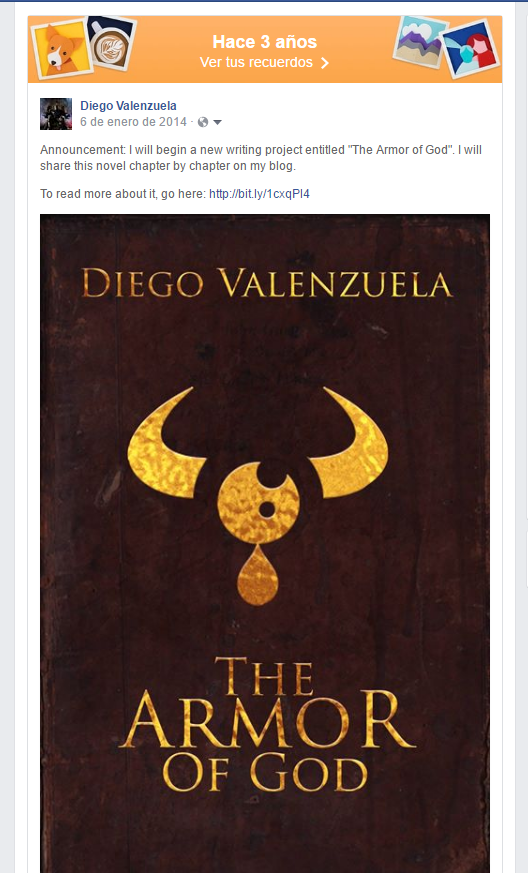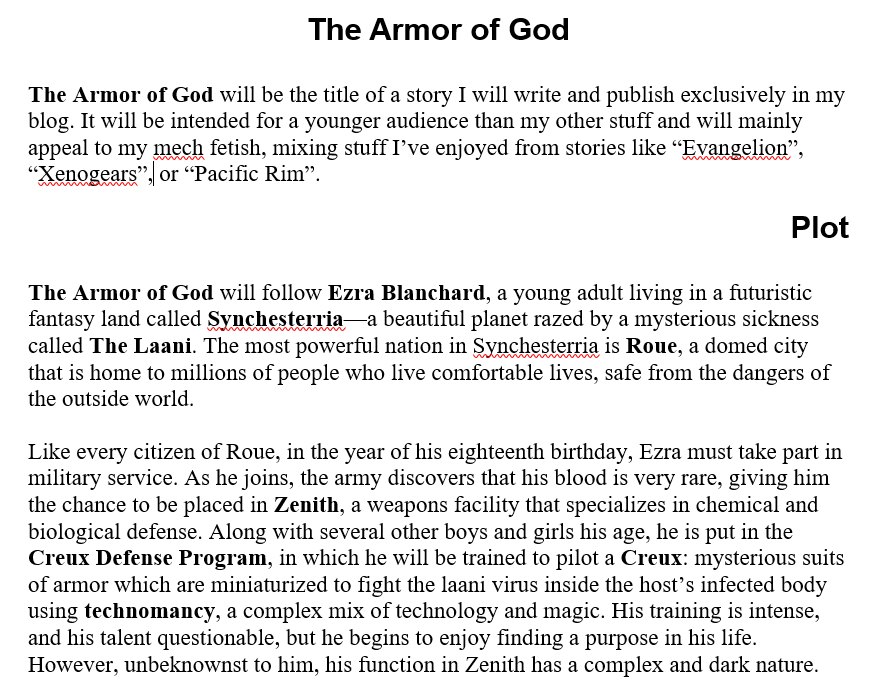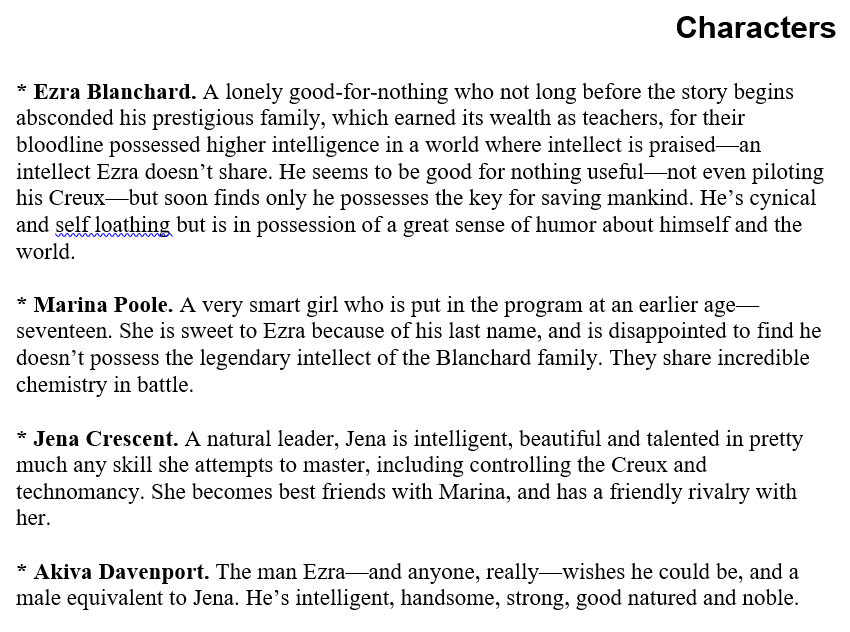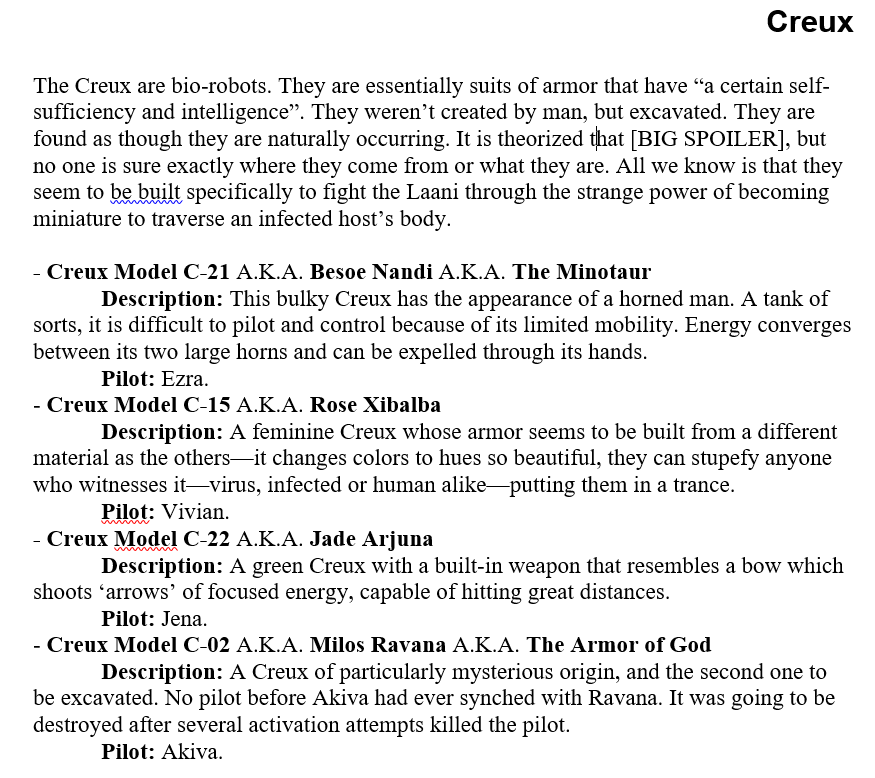I was supposed to finish and publish this days ago, on January 2nd, for maximum drama. Some shit came up and I couldn’t so let’s work together on this. Imagine it’s last week; you’re still recuperating from New Years’ Eve, Trump hasn’t opened his shitstained mouth before the press, and you’re chilling at home or flying back from vacation or whatever it is you did on January 2nd. I want to go into how the concept behind “The Armor of God” was born, how it grew, and how much it has changed in three years.

That was the cover and logo I used for the book on my blog; I posted this when I was about to post chapter 1.
I spent this Christmas/New Years in a beautiful beach house in Progreso, Yucatán, a town that’s basically a long seaside strip forty minutes away from Mérida (the city, not the fiery princess). Three years ago—for the 2013-2014 vacation—I was there as well with my family, in that very house. Not long before, I had had a dream about my homeboy Gipsy Danger from “Pacific Rim” that really made me want to write a mech story, though I didn’t think there was any possible way to make it in an interesting or original way. On the afternoon of the 1st of January, I was in the pool with my older brother. He had just finished reading “Reverie of Gods”, and we were talking about how difficult it was going to be to publish it as it was.
So he mentioned that, maybe, it’s not the type of story that should be a debut. Immediately I agreed; though “Reverie of Gods” is the favorite thing I’ve written, it’s also a bit of a big pill, and not necessarily accessible. He recommended I wrote something else, something that would be more easily marketable and sold. At first I was reluctant because I really wanted people to read “Reverie of Gods”, and it seemed way too daunting to start something from a scratch, especially considering I had at least three fully imagined novels halfway written—too bad none of them fell under “accessible” or “easily marketable”.
We came to the conclusion that this one should not be written for adults, but in a simpler and more breezy language: young adult. You should know that barring a couple of titles, I don’t like young adult fiction, at least the popular series. I decided that if I was going to write a young adult book, I would subvert the shit out of it, and even parody it. And I did.

The primordial pool.
He also came up with the idea that, if I did start writing something, I should publish it on my blog, not through any other medium. This was a good selling point because I already had Wolf in a Gorilla Suit receiving a small but steady amount of traffic, and publishing it chapter-by-chapter seemed like a good way to get instant gratification, not to mention get some fans. I didn’t, not really, but there were *some* people who did read it as I posted it (and they were all thanked as Alpha Readers in the Acknowledgments of Book 1) and that kept me going. It wasn’t until at least ten chapters in, when I got to the first big twist, that I thought: Maybe this deserves better.
I thought about not making it a single book—and that was a good idea because I can’t think of how that goddamn story could’ve wrapped in one volume—and actually getting it published through Lulu or Createspace. Slowly, I fell in love with the thing that, at first, was merely a marketing tool for a bigger book that wouldn’t see the light until several years later (hopefully). On January 2nd, 2014, I sat down on this very chair and table, and opened a Word document I called “The Mechanical Apse” (or some similar nonesensical horseshit) and wrote—literally—this:

I did re-name it “The Armor of God” later.
Reading it now I’m wondering if I did change it since then—I’m almost sure I didn’t—because that is shockingly close to the final product I finished eight months later. The largest change I can notice here is that originally I imagined that the book would take place in a fantasy world, but I deleted that; who cares if it’s a fantasy world or this one?
Most of those names I came up with on the fly. I got “Zenith” from the word written on the side of the pod that took Felix Baumgartner to space. I got “Creux” and “Roue” from the French words for “Hollow” and “Wheel”. I got “technomancy” from my own head. Then I got to the fun part: characters and, obviously, Creux.


Had to edit one huge twist.
All of these were written in a 20 minute period. Again, I’m surprised by how much of this remained untouched by the final product. Of course there were hundreds of plotlines and twists that—thankfully—didn’t make the cut. I’ll talk about how it originally looked, and how the final draft varied from the “Gorilla Suit” version at the end of this post but for now, this is genuinely surprising and delightful to me.
Naming the Creux was so much fun. I had not long before seen this badass gallery of art depicting Hindu gods as these badass almost RPG-like characters. It got me the idea for the names Arjuna, Ravana, Nandi, Indra, and probably a few more. The rest of the names I got from wherever I could find them. For instance, one of the most important names in the series—Milos—I got because the movie “Dead Silence” was playing and that was the first name that I saw when I looked up at the ending credits. I’m not kidding. Later I just loved the name and never changed it.
Funny how, if I hadn’t been browsing Imgur at that precise moment, or watching that crappy movie, I probably would have a different story at hand.
I wrote what was originally the prologue and now the beginning of Chapter 1: Ezra in line for military service, meeting Barnes. On the long highway back to Mexico City, it occurred to me that a “distant past” prologue would make more sense, and one that immediately established the story as a mech-themed epic, so I came up with Onno stumbling across Besoe Nandi in his farm.
- Fun fact 1: originally Onno was going to be revealed as a former Subject Edward, as he was infected from Nandi’s horn and started transforming into a Fleck.
- Fun fact 2: “Onno” is a name I’ve used for “the character who appears only in the prologue” for at least five unpublished stories I’ve written. It’s almost a code name.
After that, it all kind of snowballed. I created a bunch of supplementary material on my own, which I used as visual aid on the blog—and have been tempted to include in a “ultimate” edition of the trilogy—including the full roster of Creux, all of Nandi’s stats, a class schedule, logos, and more. That “side-creativity” kept me going pretty well because, as I wrote here, starting from a scratch turns you into an all-powerful overlord with infinite creative freedom.
I often use a technique to be inspired in which I make a full list of chapter titles for a book and imagine key points in which the story would take twists and turns. Originally, “chapter 7” had a huge ugly twist wherein the characters would learn the dark side of the Creux. That chapter was called “A Scream in the Dark”, and it referred to Alice’s—then called Andre—death. Why “in the dark”? Because my first instinct regarding the big twist in book one was to have both miniaturizing Creux, and giant Creux. It made no fucking sense and I changed it immediately (though I did have a cool idea where Akiva killed Jena’s dad from within because he knew the man would turn into a Fleck).
- Fun fact 3: It was specifically “chapter 7” because in “Fullmetal Alchemist”, it was in episode 7 that the characters discovered the dark side of alchemy. That’s literally part of my process; insignificant references that eventually change. In the final book, this happens in chapter 10.
I also had a “chapter 13” called “The Source of Everything” where the characters found a volcano filled with blue energy that powered the Creux. If you’ve read, this plot point was pushed ways back, and doesn’t happen until chapter 12 of book two.
I was halfway through the first book when I decided what the second half should entail: first, Ezra investigating Alice’s death; second, the big twist called “The Shattering”, and how that would lead into the finale.
I deliberately stretched the “training” part of the first book (everything leading to the destruction of Absolute Omega) by at least four or five chapters because the very first inception of the story—my Gipsy Danger dream—excited me over the idea of living “the mech life”, which involved training, meeting new people, getting to know your robot, etc. I wanted to introduce a mystery element to the first half to keep readers interested, but then realized that it would cheapen the second half’s complete narrative reroute; readers would have to be interested in the training itself, so I tried to make it as fun as I possibly could.
This, of course, also as an effort to make the twist more intense; just as things are going great and you realize you’re reading a fun and juvenile plot: pow, death and destruction and misery until the end of the trilogy. Though it’s not optimal for pacing, I want to think it worked here.
It’s insane to think about this now, but I was 100% winging it when I wrote the first book, so finding out that in the end I actually tied up in a cohesive, structurally sound narrative, it’s insane. I hate tooting my own horn but I don’t know if I’d ever be able to pull something like that off again.
Even the last three chapters (from The Shattering to the finale) I kinda let them write themselves. I wasn’t sure what I’d do to make an intense ending, which is mandatory for me, so I came up with the “urgent escape” angle almost one chapter before writing it. I even wrote on Facebook that I was sure people would be disappointed by the last chapter; it was relieving to hear readers say that they actually found it intense, because honestly it felt like I had no idea what the hell I was doing.
Now, It’s been three years since I started, and I’m some ways into the third book of the trilogy.
This is crazy. I’ve fallen in and out of love with “The Armor of God” a million times, but after writing this I’m getting some withdrawals and am aching to go back to “The God That Failed” (update tomorrow). When I’m done with it, I’ll move on to another story that has be hot and bothered, but not yet. Right now it’s time to go back to the wasteland, where some serious shit is going on.
I hope to release “The God That Failed” in Q4 2017, and I want it to be the best, most intense, most emotionally draining/rewarding of the trilogy.
Just so you can see how many times a writer’s first instincts are totally mistaken, here are some key differences between the “Gorilla Suit” and “Amazon” versions of “The Armor of God”:
- Names were different. Vivian was Marina; Garros was Eldridge; Erin was Annie (in direct reference to “Community” Annie Edison/Britta Perry); Alice was Andrea; Tessa was Sadie. I might be missing a couple others.
- The “world” was called Synchesterria, an amalgamation of Devin Townsend’s albums “Synchestra” and “Terria”.
- They really did become miniature for some of the plotting time, but I never actually wrote it that way. I’m glad, because it totally destroyed the big twist and was inelegant as fuck.
- In very early inceptions, there was a mysterious super powerful black Creux that helped them when they were in trouble and disappeared; he was going to be an alternate version of Milos Ravana, and the plotline eventually turned into Lazarus in “The Unfinished World”, though he’s a villain now.
- Both Ezra and Garros took a medicine that, unbeknownst to them, made them physically stronger so they could control Tanks better. I deleted it because Ezra’s physical transformation in the first book is one of his most interesting aspects, and didn’t want to cheapen it.
- The “Leonard is Subject Edward” twist didn’t exist; that was a last-minute addition that worked really well in my opinion. Like I said, I seriously considered making Onno Subject Edward, but it was both too cruel and didn’t have any of the emotional impact.
- Ezra’s dad actually had a role to play; that changed so now his big role takes place in the third book.
- Poole was a much, much bigger bitch. She was way too annoying even to me, so I had to tone it way down.
- Garros and Erin were overt about having sex, though they weren’t really a couple.
- There was a lot of profanity; Garros in particular spoke like the Devil on the toilet.
Man, this book could’ve been pretty bad. Even if it’s “just okay”, I’m glad I changed what I did.
Hope you enjoyed reading a little insight into the first book.

